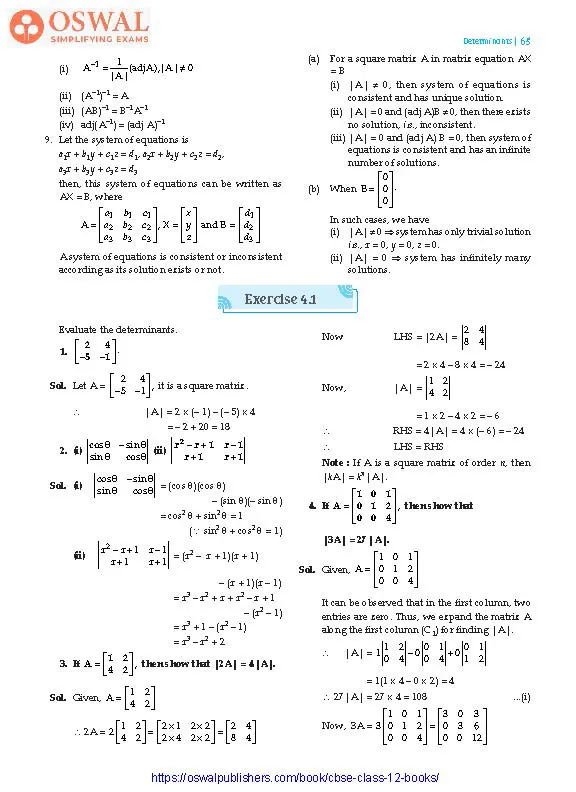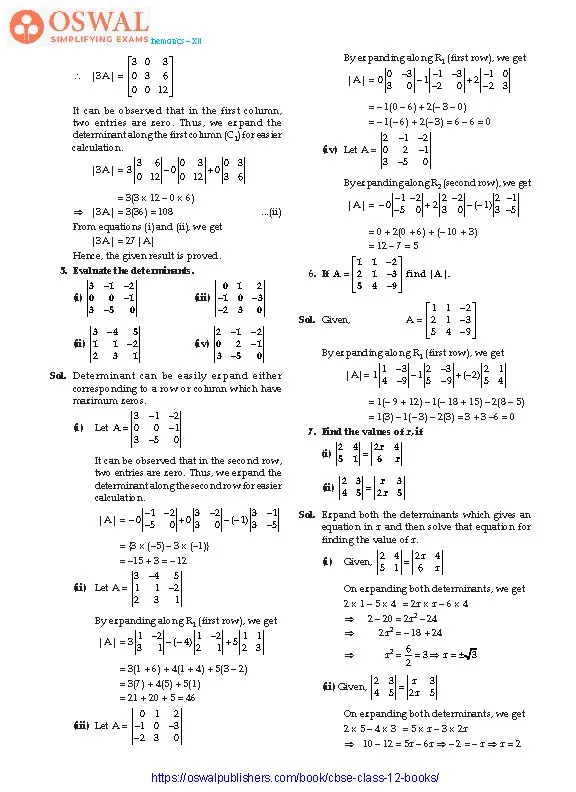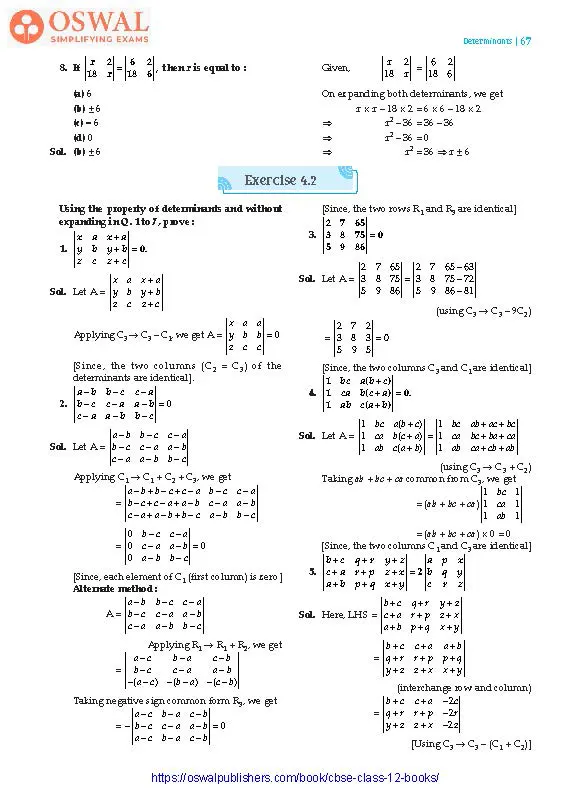NCERT Solutions for Class 12 Maths Chapter 4 Determinants - Exercise 4.1



Access Exercises of Class 12 Maths Chapter 4 –Determinants
Exercise 4.1 Solutions: 8 Questions (2 Long, 5 Short Answers, 1 MCQ)
Exercise 4.2 Solutions: 16 Questions(7 Long, 7 Short, 2 MCQs)
Exercise 4.3 Solutions: 5 Questions ( 4 Short Answers, 1 MCQ)
Exercise 4.4 Solutions: 5 Questions (4 Long, 1 MCQ)
Exercise 4.5 Solutions: 18 Questions (11 Long, 5 Short, 2 MCQs)
Exercise 4.6 Solutions: 16 Questions (13 Long, 3 Short)
Miscellaneous Exercise Solutions: 19 Questions (15 Long, 1 Short, 3 MCQs)
Exercise 4.1
Evaluate the determinants.
$$\textbf{1.\space}\begin{bmatrix}\textbf{2} &\textbf{4}\\\textbf{\normalsize-5} &\textbf{\normalsize-1}\end{bmatrix}\textbf{.}\\\textbf{Sol.\space}\text{Let A = }\begin{bmatrix}2 &4\\\normalsize-5 &\normalsize-1\end{bmatrix},$$
it is a square matrix.
∴ |A| = 2 × (– 1) – (– 5) × 4
= – 2 + 20 = 18
$$\textbf{2.\space (i)\space}\begin{vmatrix}\textbf{cos}\space\theta &-\textbf{sin}\space\theta\\\textbf{sin}\space\theta &\textbf{cos}\space\theta\end{vmatrix}\\\textbf{(ii)\space}\begin{vmatrix}\textbf{x}^{\textbf{2}} \textbf{- x+1} &\textbf{x+1}\\\textbf{x+1} &\textbf{x+1}\end{vmatrix}\\\textbf{Sol.\space (i)\space}\begin{vmatrix}\text{cos}\space\theta &-\text{sin}\space\theta\\\text{sin}\space\theta &\text{cos}\space\theta\end{vmatrix}\\$$
= (cos θ)(cos θ) – (sin θ)(– sin θ)
= cos2 θ + sin2 θ = 1
(∵ sin2 θ + cos2 θ = 1)
$$\text{(ii)}\space\begin{vmatrix}x^{2}-x+1 &x-1\\x+1 &x+1\end{vmatrix}\\=(x^{2}-x+1)(x+1)-\\(x+1)(x-1)$$
= x3 – x2 + x + x2 – x + 1 – (x2 – 1)
= x3 + 1 – (x2 – 1)
= x3 – x2 + 2
$$\textbf{3.\space If A} = \begin{bmatrix}\textbf{1} &\textbf{2}\\\textbf{4} &\textbf{2}\end{bmatrix}\textbf{,}$$
then show that |2A| = 4|A|.
$$\textbf{Sol.\space} \text{Given,}\space\text{A} = \begin{bmatrix}1 &2\\4 &2\end{bmatrix}\\\therefore\space \text{2A = 2}\begin{bmatrix}1 &2\\4 &2\end{bmatrix}\\=\begin{bmatrix}2×1 &2×2\\2×4 &2×2\end{bmatrix}= \begin{bmatrix}2 &4\\8 &4\end{bmatrix}\\\text{Now LHS = |2A| =}\begin{vmatrix}2 &4\\8 &4\end{vmatrix}$$
= 2 × 4 – 8 × 4 = – 24
$$\text{Now,\space}\text{|A| = }\begin{vmatrix}1 &2\\ 4 &2\end{vmatrix}$$
= 1 × 2 – 4 × 2 = – 6
∴ RHS = 4|A| = 4 × (– 6) = – 24
∴ LHS = RHS
Note : If A is a square matrix of order n, then |kA| = kn|A|.
$$\textbf{4.\space If A = }\begin{bmatrix}\textbf{1} &\textbf{0} &\textbf{1}\\\textbf{0} &\textbf{1} &\textbf{2}\\\textbf{0} &\textbf{0} &\textbf{4}\end{bmatrix}\textbf{,}$$
then show that |3A| = 27|A|.
$$\textbf{Sol.\space}\text{Given, A = }\begin{bmatrix}1 &0 &1\\0 &1 &2\\0 &0 &4\end{bmatrix}$$
It can be observed that in the first column, two entries are zero. Thus, we expand the matrix A along the first column (C1) for finding |A|.
$$\therefore\space|\text{A}| = 1\begin{vmatrix}1 &2\\ 0 &4\end{vmatrix} -0\begin{vmatrix}0 &1\\ 0 &4\end{vmatrix}+\\\begin{vmatrix}0 &1\\1 &2\end{vmatrix}$$
= 1(1 × 4 – 0 × 2) = 4
∴ 27|A| = 27 × 4 = 108 ...(i)
$$\text{Now, 3A =} \\3\space\begin{bmatrix}1 &0 &1\\0 &1 &2\\0 &0 &4\end{bmatrix} = \begin{bmatrix}3 &0 &3\\0 &3 &6\\0 &0 &12\end{bmatrix}\\\therefore\space|3\text{A}| = \begin{bmatrix}3 &0 &3\\0 &3 &6\\0 &0 &12\end{bmatrix}$$
It can be observed that in the first column, two entries are zero. Thus, we expand the determinant along the first column (C1) for easier calculation.
$$|3\text{A}| = 3\begin{vmatrix}3 &6\\0 &12\end{vmatrix} -0 \begin{vmatrix}0 &3\\0 &12\end{vmatrix}+\\0\begin{vmatrix}0 &3\\3 &6\end{vmatrix}$$
= 3(3 × 12 – 0 × 6)
$$\Rarr\space|3A| = 3(36) = 108\space\text{...(ii)}$$
From equations (i) and (ii), we get
|3A| = 27|A|
Hence, the given result is proved.
5. Evaluate the determinants.
$$\textbf{(i)\space}\begin{vmatrix}\textbf{3} &\normalsize\textbf{-1} &\normalsize\textbf{-2}\\\textbf{0} &\textbf{0} &\textbf{\normalsize-1}\\\textbf{3} &\normalsize\textbf{-5} &\textbf{0}\end{vmatrix}\\\textbf{(ii)\space}\begin{vmatrix}\textbf{3} &\textbf{\normalsize-4} &\textbf{5}\\\textbf{1} &\textbf{1} &\textbf{\normalsize-2}\\\textbf{2} &\textbf{3} &\textbf{1}\end{vmatrix}\\\textbf{(iii)\space}\begin{vmatrix}\textbf{0} &\textbf{1} &\textbf{2}\\\textbf{\normalsize-1} &\textbf{0} &\textbf{\normalsize-3}\\\textbf{\normalsize-2} &\textbf{3} &\textbf{0}\end{vmatrix}\\\textbf{(iv)\space}\begin{vmatrix}\textbf{2} &\textbf{\normalsize-1} &\textbf{\normalsize-2}\\\textbf{0} &\textbf{2} &\textbf{\normalsize-1}\\\textbf{3} &\textbf{\normalsize-5} &\textbf{0}\end{vmatrix}$$
Sol. Determinant can be easily expand either
corresponding to a row or column which have
maximum zeros.
$$\textbf{(i)\space} \text{Let A = }\begin{vmatrix}3 &\normalsize-1 &\normalsize-2\\0 &0 &\normalsize-1\\ 3 &\normalsize-5 &0\end{vmatrix}$$
It can be observed that in the second row, two entries are zero. Thus, we expand the determinant along the second row for easier calculation.
$$\text{|A|} = -0\begin{vmatrix}\normalsize-1 &\normalsize-2\\\normalsize-5 &0\end{vmatrix} + 0\begin{vmatrix}3 &\normalsize-2\\3 &0\end{vmatrix}-\\(\normalsize-1)\begin{vmatrix}3 &\normalsize-1\\3 &\normalsize-5\end{vmatrix}$$
= {3 × (–5) – 3 × (–1)}
= –15 + 3 = – 12
$$\textbf{(ii)\space}\text{Let A =}\begin{vmatrix}3 &\normalsize-4 &5\\1 &1 &\normalsize-2\\2 &3 &1\end{vmatrix}$$
By expanding along R1 (first row), we get
$$|\text{A}| = 3\begin{vmatrix}1 &\normalsize-2\\3 &1\end{vmatrix} - (\normalsize-4)\begin{vmatrix}1 &\normalsize-2\\2 &1\end{vmatrix}\\+5\begin{vmatrix}1 &1\\2 &3\end{vmatrix}$$
= 3(1 + 6) + 4(1 + 4) + 5(3 – 2)
= 3(7) + 4(5) + 5(1)
= 21 + 20 + 5 = 46
$$\textbf{(iii)\space}\text{Let A} = \begin{vmatrix}0 &1 &2\\\normalsize-1 &0 &\normalsize-3\\\normalsize-2 &3 &0\end{vmatrix}$$
By expanding along R1 (first row), we get
$$|\text{A}| = 0\begin{vmatrix}0 &\normalsize-3\\3 &0\end{vmatrix}-1\begin{vmatrix}\normalsize-1 &\normalsize-3\\\normalsize-2 &0\end{vmatrix}+\\2\begin{vmatrix}\normalsize-1 &0\\\normalsize-2 & 3\end{vmatrix}$$
= – 1(0 – 6) + 2(– 3 – 0)
= – 1(– 6) + 2(– 3) = 6 – 6 = 0
$$\textbf{(iv)\space}\text{Let A = }\begin{vmatrix}2 &\normalsize-1 &\normalsize-2\\0 &2 &\normalsize-1\\3 &\normalsize-5 &0\end{vmatrix}$$
By expanding along R2 (second row), we get
$$\text{|A|} =-0\begin{vmatrix}\normalsize-1 & \normalsize-2\\\normalsize-5 &0\end{vmatrix} + 2\begin{vmatrix}2 &\normalsize-2\\3 &0\end{vmatrix}\\-(\normalsize-1)\begin{vmatrix}2 &\normalsize-1\\3 & \normalsize-5\end{vmatrix}$$
= 0 + 2(0 + 6) + (– 10 + 3)
= 12 – 7 = 5
$$\textbf{6. If A =}\begin{bmatrix}\textbf{1} &\textbf{\normalsize-1} &\textbf{\normalsize-2}\\\textbf{2} &\textbf{1} &\textbf{\normalsize-3}\\\textbf{5} &\textbf{4} &\textbf{\normalsize-9}\end{bmatrix}\\\textbf{find}\space|\textbf{A}|.\\\textbf{Sol.\space}\text{Given,\space}\text{A = }\begin{bmatrix}1 &1 &\normalsize-2\\2 &1 &\normalsize-3\\5 &4 &\normalsize-9\end{bmatrix}$$
By expanding along R1 (first row), we get
$$\text{|A|} = 1\begin{vmatrix}1 &\normalsize-3\\4 &\normalsize-9\end{vmatrix}\normalsize-1\begin{vmatrix}2 &\normalsize-3\\5 &\normalsize-9\end{vmatrix}+\\(\normalsize-2)\begin{vmatrix}2 &1\\5 &4\end{vmatrix}$$
= 1(– 9 + 12) – 1(– 18 + 15) – 2(8 – 5)
= 1(3) – 1(– 3) – 2(3) = 3 + 3 –6 = 0
7. Find the values of x, if
$$\textbf{(i)\space}\begin{vmatrix}\textbf{2} &\textbf{4}\\\textbf{5} &\textbf{1}\end{vmatrix} \textbf{=} \begin{vmatrix}\textbf{2x} &\textbf{4}\\\textbf{6} &\textbf{x}\end{vmatrix}\\\textbf{(ii)\space}\begin{vmatrix}\textbf{2} &\textbf{3}\\\textbf{4} &\textbf{5}\end{vmatrix}\textbf{=}\begin{vmatrix}x &\textbf{3}\\\textbf{2x} &\textbf{5}\end{vmatrix}$$
Sol. Expand both the determinants which gives an equation in x and then solve that equation for finding the value of x.
$$\textbf{(i)\space}\text{Given,}\begin{vmatrix}2 &4\\5 &1\end{vmatrix} = \begin{vmatrix}2x &4\\6 &x\end{vmatrix}$$
On expanding both determinants, we get
2 × 1 – 5 × 4 = 2x × x – 6 × 4
$$\Rarr\space 2-20 = 2x^{2}-24\\\Rarr\space 2x^{2} =-18 + 24\\\Rarr\space x^{2} =\frac{6}{2} =3\\\Rarr\space x=\pm\sqrt{3}$$
$$\textbf{(ii)\space}\text{Given,}\begin{vmatrix}2 &3\\4 &5\end{vmatrix} = \begin{vmatrix}x &3\\2x &5\end{vmatrix}$$
On expanding both determinants, we get
2 × 5 – 4 × 3 = 5 × x – 3 × 2x
$$\Rarr\space 10-12 = 5x-6x\\\Rarr\space -2 =-x\space \Rarr x=2$$
$$\textbf{8.\space If}\begin{vmatrix}\textbf{x} &\textbf{2}\\\textbf{18} & \textbf{x}\end{vmatrix} \textbf{=}\begin{vmatrix}\textbf{6} &\textbf{12}\\\textbf{18} &\textbf{6}\end{vmatrix}\textbf{,} $$
then x is equal to :
(a) 6
(b) ± 6
(c) – 6
(d) 0
Sol. (b) ± 6
$$\text{Given,\space}\\\begin{vmatrix}x &2\\18 &x\end{vmatrix}\begin{vmatrix}6 &2\\18 &6\end{vmatrix}$$
On expanding both determinants, we get
x × x – 18 × 2 = 6 × 6 – 18 × 2
$$\Rarr\space x^{2}-36 = 36-36\\\Rarr\space x^{2} - 36=0\\\Rarr\space x^{2} = 36\\\Rarr\space x\pm\space6$$
